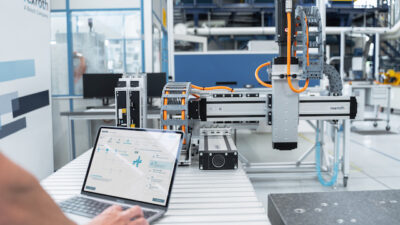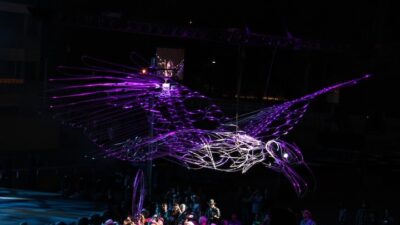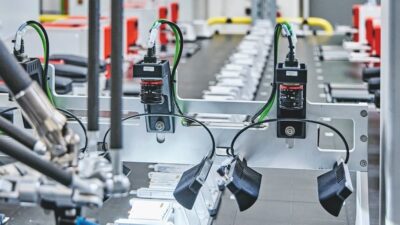Industrial applications represent the mainstream for motion control, but recent spectacular examples from the "entertainment industry" are hard to ignore. In-deed, applications in the cinema, stage, amusement park rides, and other visible venues continue to push motion technology's envelope.One notable example from the entertainment field is "Masquerade Show in the Sky.
Sidebars: Faster, smarter, simpler…
Industrial applications represent the mainstream for motion control, but recent spectacular examples from the “entertainment industry” are hard to ignore. In-deed, applications in the cinema, stage, amusement park rides, and other visible venues continue to push motion technology’s envelope.
One notable example from the entertainment field is “Masquerade Show in the Sky.” This show application involves synchronized motion on 17 stages at the Rio Suite Hotel & Casino in Las Vegas. It combines animatronic figures, live performers, and five mobile carnival-themed floats—suspended from the ceiling and performing above the gaming floor (see photo). Automation and show control systems were developed by Scenic Technologies (New Windsor, N.Y.) using motion control products from Rockwell Automation (Milwaukee, Wis.). See more in the previous article’s sidebar.
Some industrial applications, while not as entertaining, also help advance motion technology.
Printing machines, vision systems
Sun Automation (Sparks, Md.), an original equipment manufacturer of printing machines had just a “small design team to meet a tight deadline” for bringing a high-speed printing unit on line. It used a PowerMotion system from GE Fanuc (Charlottesville, Va.) that features Beta Series servos, Series 90-30 PLCs, and Cimplicity HMI. The motion system lets operators select and record 16 position-control axes for rapidly setting up and printing 335 impressions/minute.
Craig Propert, electrical design supervisor at Sun, says, “Design time and installation cost were trimmed substantially through plug-and-play connections in the PowerMotion system. This approach eliminated custom cables and printed circuit boards, used common components in machine sections, and minimized wiring.”
MicroVu Corp. (Windsor, Calif.) markets the Quantum Series automated vision measuring machine capable of indexing at speeds of 17 to 28 in./sec, with accuracies better than one micron (10-3mm). The noncontact system visually checks dimensions and proportions of semiconductor wafers. One key component is the machine’s linear servo motor from Kollmorgen ( Radford, Va.). Ed Amormino, MicroVu president, says, “Smooth technology and extreme precision of linear motors have enabled MicroVu to produce faster, more accurate measuring systems.”
Electrolux Compressor Companies (ECC, Turin, Italy) is said to be the world’s largest manufacturer of refrigerator compressors. ECC uses an ADMC330 embedded DSP (digital signal processing) motor controller from Analog Devices Inc. (ADI, Wilmington, Mass.) in its new designs. Results from incorporating ADI’s DSP controller include new compressor-control capabilities, allowing refrigerators to adjust motor speed within the compressor. This helps optimize temperature and thus significantly increases energy efficiency. According to Matteo Bellomo, senior vice president for R&D at Electrolux Compressor, “Energy conservation is rapidly becoming a mandatory requirement for appliance manufacturers. To achieve this goal, we looked for a system-level IC partner with motor control expertise who could provide advanced performance at low cost.”
Creative Technology Corp. (Arlington Heights, Ill.) uses a PMAC2 controller from Delta Tau Data Systems (Northridge, Calif.) as the core of its PC-based, high-speed 3D contouring machine-tool controllers. To permit high-speed machining whenever possible—and not sacrifice accuracy at any point—the machine tool relies on special “look ahead” algorithms that anticipate areas requiring low speed and timely deceleration. “Open architecture of the PMAC2” permits Creative’s lookahead algorithms to be implemented. Servo performance of PMAC2, with on-board commutation and digital current-loop closure, allows the high velocities, accelerations, and accuracies needed.
Automotive painting
Behr Systems (Auburn Hills, Mich.) builds spray painting systems for automobile manufacturers. Its patented application using PMAC2 controllers with MACRO fiber-optic link to the drives—both Delta Tau products—resulted in dramatic reduction of wiring and cabinetry. At the same time the systems’ software structure remained simple, with highly centralized control and standard communications protocols going to the remote drives.
At Binks Sames Corp. (Livonia, Mich.), a servo drive from API Controls is combined with an API Gettys’ explosion-proof brushless servo motor to precisely control a paint pump delivery subsystem. It’s part of an electrostatic painting system for the auto industry made by Binks. The Centennial drive’s adaptive load compensation and auxiliary PID loop are well tested in this application. API Controls and API Gettys are among six subsidiaries of API Motion Inc. (Amherst, N.Y.).
In another industry, 13 of API Controls’ DM224i Intelligent Microstepping drives connect via an RS-485 line to a PC host that automates testing of medical aerosol inhalers at Glaxo-Wellcome, (Research Triangle Park, N.C.). The procedure tests the inhalers for proper particle size distribution.
‘Links’ of another type
Titleist Div., Acushnet Co. (New Bedford, Mass.), a leading manufacturer of golf balls, needed to integrate high-speed control with high-level communications, five-axis servo control, and programmable logic. Tom Mydlack, director of engineering at Acushnet’s plant selected automation controllers from Control Technology Corp. (CTC, Hopkinton, Mass.). He considers these controllers unique for obtaining the combination of all necessary machine control functions in a single package.
Mr. Mydlack is also positive about CTC’s Quickstep software that uses state-logic language to simplify complex machine sequencing, along with training and troubleshooting of the system.
Bruker AXS Inc. (Madison, Wis.) manufactures a complete line of X-ray diffraction instruments. Recently, the company faced the challenge of designing its own control board to reduce cost. To do so, it needed to incorporate all necessary features for a complete motion control system onto a single full-size ISA bus interface.
“We analyzed the cost of an off-the-shelf solution and compared it to the projected single-board solution using the PMD chipset,” says Greg Wachter, electronics engineer at Bruker AXS. The chipset is the MC1451A for stepper control of one to four axes, from Performance Motion Devices (Concord, Mass.). “It was shown to be more cost effective to design and build our own boards [with the chipset] that would provide all the functions necessary to control the stepper motors,” adds Mr. Wachter.
Added benefits of an all-in-one solution at Bruker include software control of virtually all step motor parameters—for example, winding current, driver enable/disable, microstepping resolution, home and limit switch polarities, motor move direction, encoder readout direction, encoder type, and standby current mode.
The technologies we call motion control have many facets. They provide numerous possibilities for user solutions in virtually limitless applications.
For other motion control companies mentioned, visit www.controleng.com/info
Faster, smarter, simpler…
Motion control is a technology under positive chaotic change. Integration of silicon and software to the electric motor and power transmission, that interfaces to the customer’s mechanism, supplies a wide range of users with a flexible programmable motion control platform. There are tens of thousands of applications using electric motors—both small and large—in the home, office, factory floor, and literally in “planes, trains, and automobiles.”
Different segments of the motion market must provide new equipment that outperforms the previous equipment generation. The overall market demand can best be summarized as combinations of the following: Faster, smarter, simpler, smoother, smaller, better, safer, quieter, cheaper.
No one product can meet five or six of these demands, but the challenge is there for the motion control component and system supplier to furnish as many as possible. Market success or failure is based on how many or how few of these demand elements the supplier can incorporate in its new motion control product.



